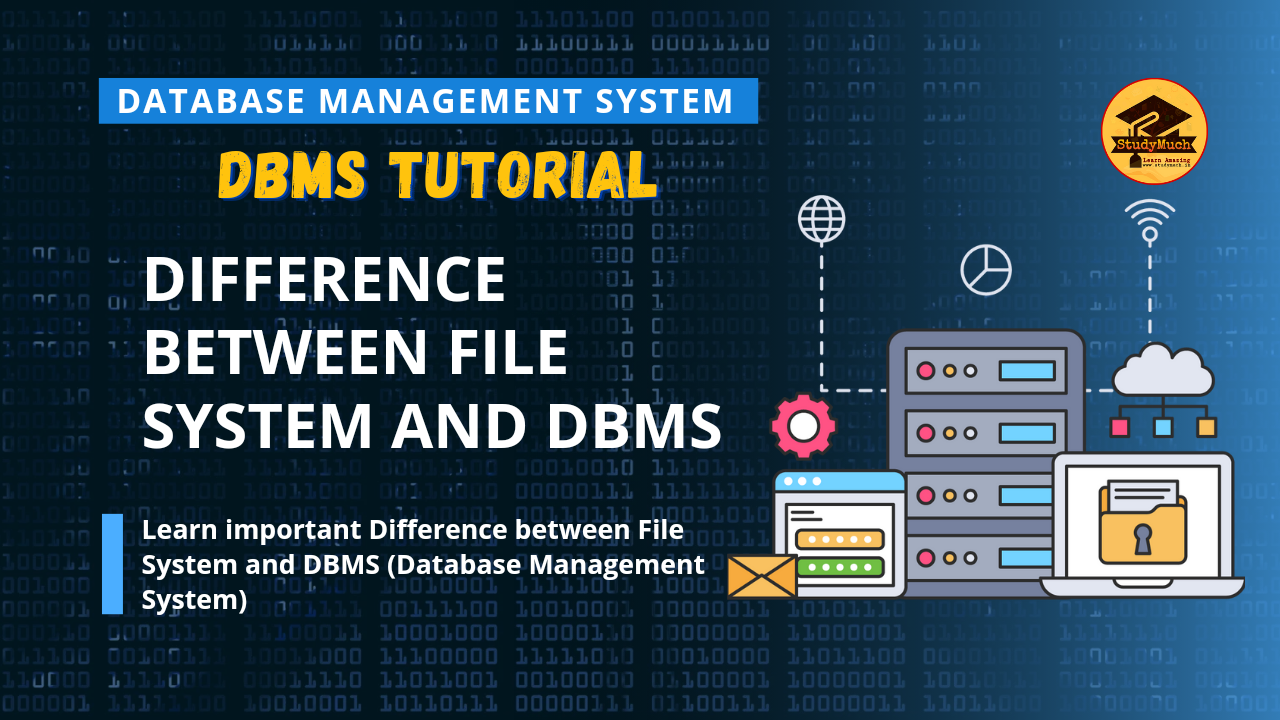Difference Between File System and DBMS

Difference Between File System and DBMS
Data management is an essential component of computers that guarantees effective information storage, retrieval, and modification. Database management systems (DBMS) and file systems are two popular ways to manage data. Although at first glance they can appear to be identical, their structure, functioning, and application cases are very different. We will examine the main distinctions between file systems and DBMS in this blog post.
Structure of Filesystem and DBMS
A file system is a basic method of organizing and storing data on a computer’s storage medium, such as a hard disk drive. It uses a hierarchical structure with directories (folders) and files, where files are stored in directories, and directories can contain other directories or files. Each file in a file system has a unique name and is accessed using the path from the root directory.
On the other hand, a DBMS is a complex software system that organizes and stores data in a structured manner. It uses a relational model that consists of tables with rows and columns, where each row represents a record, and each column represents an attribute. Tables in a DBMS are related through keys, such as primary keys and foreign keys, which enable the establishment of relationships and dependencies between different tables.
Functionality in DBMS and File system
File systems primarily provide basic operations such as create, read, update, and delete (CRUD) for managing files and directories. They allow users to organize files into folders, set permissions, and perform basic file operations such as copy, move, and rename. However, file systems do not provide advanced data management capabilities such as data integrity, data validation, and data consistency.

DBMS provides advanced data management functionalities beyond CRUD operations. It offers complex querying capabilities that allow users to retrieve data based on various conditions and criteria. It also supports data validation, integrity constraints, and transaction management, ensuring that data remains consistent, accurate, and secure. Additionally, DBMS provides features such as indexing, caching, and data replication for improved performance and scalability.
Use cases of File System and DBMS
Storing and organizing files for personal or small-scale use are typical simple data management tasks for which file systems are utilized. They are appropriate for jobs that don’t call for intricate data manipulation, protracted data queries, or user-wide data sharing. Operating systems, file servers, and cloud storage services all frequently use file systems.
DBMS are created for managing big amounts of data with intricate dependencies. They are frequently used in business applications, websites, e-commerce platforms, and other situations requiring effective and reliable data handling. DBMS are appropriate for jobs that require regular data updates, intricate data queries, and simultaneous access by numerous users. They are perfect for managing crucial company data because they offer a high level of data integrity, security, and scalability.
Difference Between File System and DBMS
There are the following differences between DBMS and File systems:
| Basis | DBMS | File System |
| Meaning | DBMS is a collection of data. In DBMS, the user is not required to write the procedures. | The file system is a collection of data. In this system, the user has to write the procedures for managing the database. |
| Sharing of data | Due to the centralized approach, data sharing is easy. | Data is distributed in many files, and it may be of different formats, so it isn’t easy to share data. |
| Data Abstraction | DBMS gives an abstract view of data that hides the details. | The file system provides the detail of the data representation and storage of data. |
| Security and Protection | DBMS provides a good protection mechanism. | It isn’t easy to protect a file under the file system. |
| Recovery Mechanism | DBMS provides a crash recovery mechanism, i.e., DBMS protects the user from system failure. | The file system doesn’t have a crash mechanism, i.e., if the system crashes while entering some data, then the content of the file will be lost. |
| Manipulation Techniques | DBMS contains a wide variety of sophisticated techniques to store and retrieve the data. | The file system can’t efficiently store and retrieve the data. |
| Concurrency Problems | DBMS takes care of Concurrent access of data using some form of locking. | In the File system, concurrent access has many problems like redirecting the file while deleting some information or updating some information. |
| Where to use | Database approach used in large systems which interrelate many files. | File system approach used in large systems which interrelate many files. |
| Cost | The database system is expensive to design. | The file system approach is cheaper to design. |
| Data Redundancy and Inconsistency | Due to the centralization of the database, the problems of data redundancy and inconsistency are controlled. | In this, the files and application programs are created by different programmers so that there exists a lot of duplication of data which may lead to inconsistency. |
| Structure | The database structure is complex to design. | The file system approach has a simple structure. |
| Data Independence | In this system, Data Independence exists, and it can be of two types.
|
In the File system approach, there exists no Data Independence. |
| Integrity Constraints | Integrity Constraints are easy to apply. | Integrity Constraints are difficult to implement in file system. |
| Data Models | In the database approach, 3 types of data models exist:
|
In the file system approach, there is no concept of data models exists. |
| Flexibility | Changes are often a necessity to the content of the data stored in any system, and these changes are more easily with a database approach. |
The flexibility of the system is less as compared to the DBMS approach. |
| Examples |
Oracle, SQL Server, Sybase etc. |
Cobol, C++ etc. |
So, in this tutorial you have learn difference between File System and Database Management System (DBMS). I hope you learned this tutorial well and if you have any doubt and problem then you can ask in the comment section.
Learn Also;



1 Comment
tlovertonet · May 5, 2024 at 11:42 pm
Great write-up, I’m normal visitor of one’s site, maintain up the nice operate, and It’s going to be a regular visitor for a lengthy time.